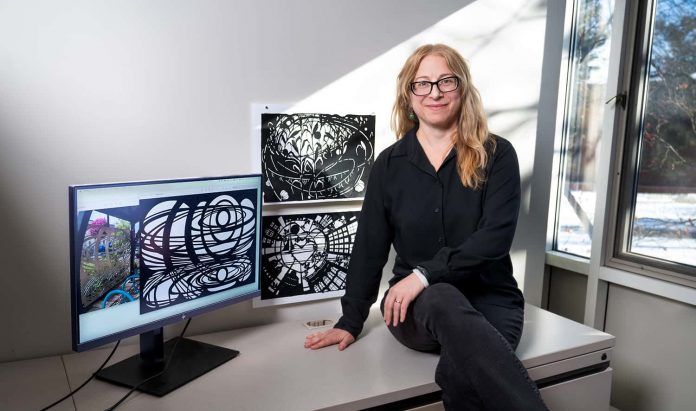Professor of Art and Design Mia Brownell does not live in Geneva, N.Y., but is now tied to the city’s recent renaissance by chance, and by corn.
On a routine commute through the Finger Lakes in 2020, Brownell came across a public call for submissions to design bicycle shelters as part of a $10 million revitalization effort to Geneva’s historic downtown area. One submission later, Brownell was awarded the public art commission to design all three shelters. Each shelter features one of Brownell’s ethereal, molecular-based designs laser-cut into sheet metal, with each design inspired by agricultural, entrepreneurial, or political initiatives enacted by residents throughout the city’s history.
“New York is a halfway point between where I live and where my mother-in-law lives,” Brownell said. “We stop and spend the night in Geneva to break up the drive. When I saw a call for public art in Geneva, I submitted a proposal for one of the bike shelters. Soon after, the Revitalization Committee responded, ‘You’re a finalist, would you please consider submitting a proposal for all three shelters?’ And I said, ‘sure.’”
The committee’s selection of Brownell’s work was fitting as it focuses on the convergence of molecular science, and the impact food culture has on society. She employs the lush visual aesthetics of 17th-century Dutch still-life realism, utilizing familiar subjects like grapes, pears, lemons, and butchered meat to create evocative and dream-like images modeled after neurobiological structures, like synapses of the brain or the chain-like structures of protein molecules.
“I use the conventions of traditional still life to comment on contemporary food culture,” she said. “You are what you eat. Eating is an intersection with our bodies, our body image, the industrialized world, the industrialized food complex, of course, science, and the environment.”
The call for art Brownell responded to focused on Geneva’s historical connection to “The Three Sisters,” an agricultural system of growing vegetables in which corn, beans, and squash are planted together — developed by the indigenous Iroquois and Cherokee peoples. “The Three Sisters dovetails into my core body of work,” she said.
The design she entered, titled “Sisters Market,” depicts intersectional themes of food consumption, from the growing of food, to the act of bringing food to markets to sell, to the very fundamental visual structures of the protein molecules the food nourishes us with.
Brownell’s other two designs are titled “Hope,” which honors Geneva’s long-standing focus on social justice, and “City Currents,” which depicts Geneva’s iconic buildings.
The call for art was made to satisfy the city’s need for public art as included in the Geneva Downtown Vision Plan, the blueprint for the revitalization effort. The plan includes a line item specifically for a Public Art Program to the sum of $200,000.
“Funding for this project will support the Public Art Committee in executing a competitive ‘Call for Proposals’ to local and regional artists to execute the Public Arts Plan and incorporate public artwork within the downtown,” the vision plan states.
Brownell responded to the duality of the shelters as both safe places to store bikes and as public art with ties to social justice by saying, “The nature of public art is probably the deepest connection to social justice. Public art is to be enjoyed by everyone — and that was my job as the designer – to try and create a design that would be enjoyed by everyone.”
Having worked on this project remotely over the pandemic, Brownell said she had not seen her designs in person until her most recent trip through Geneva, and she reminisces about the project having finally seen them in person last year. “I had not seen them in real life because I was commissioned to only design them. They existed in my head and on paper and then as a vector,” she said, explaining her remote role as just the designer and not the fabricator.
“This was a unique project for me as I am an old-school ‘painter,’” she said. “I used black and white ink on paper and then took a picture of the design and converted it to a vector file,” she said, explaining how different this process was for her. “I did not have to fabricate it. I usually do everything by hand.”
When asked if she would consider designing something in vector format again, she said, “Every painting I make, every project, is a puzzle. This was just a slightly different puzzle for me to solve. I loved it.”
A solo exhibition featuring Brownell’s oil paintings will be on display at Catskill Art Space in Livingston Manor, N.Y., beginning in November 2025. The bike shelters are on permanent display in downtown Geneva, N.Y.


